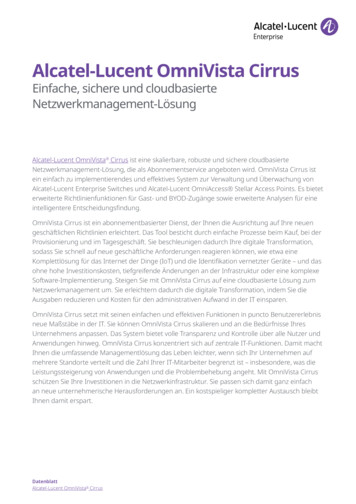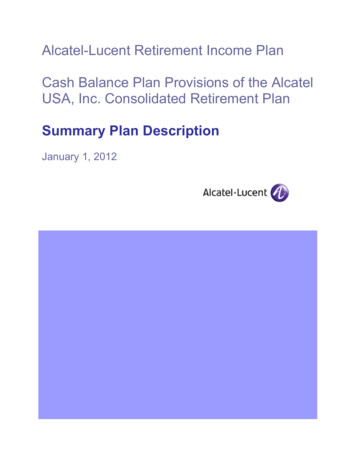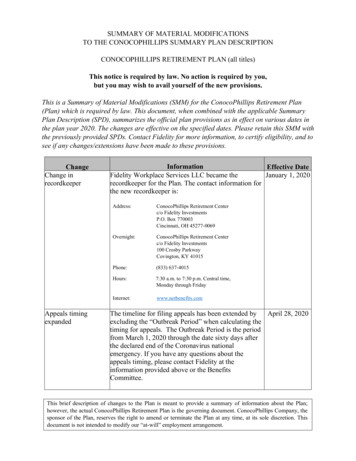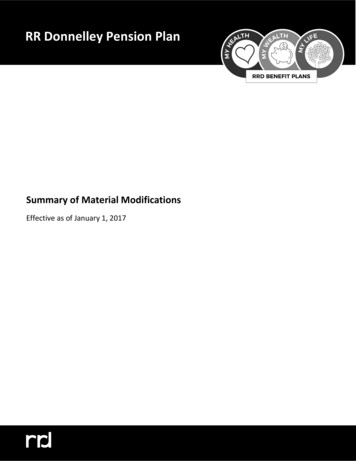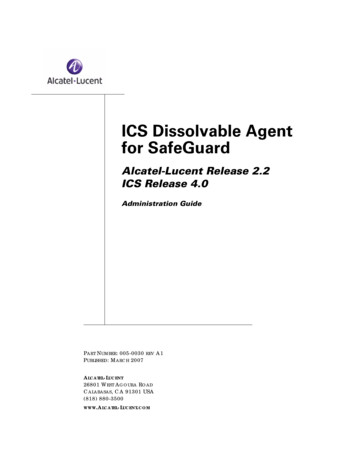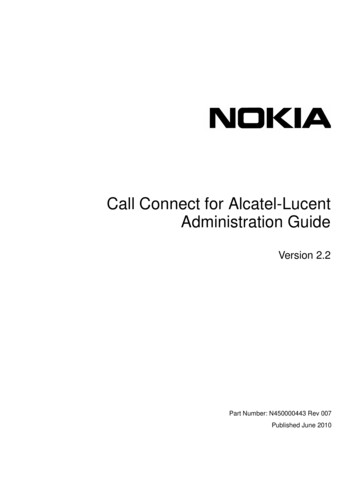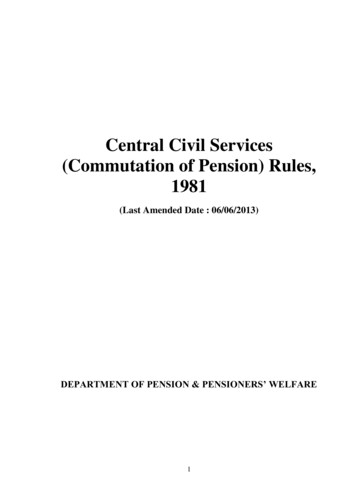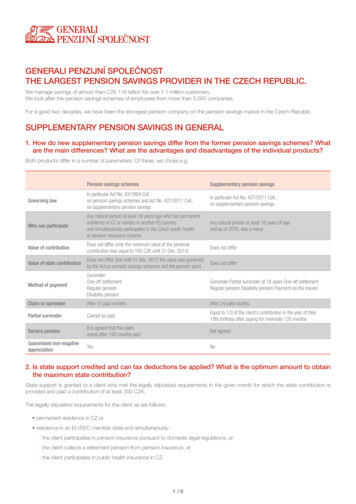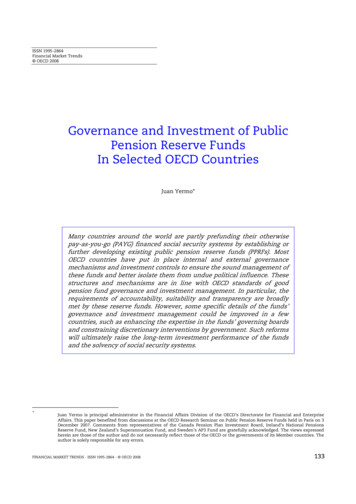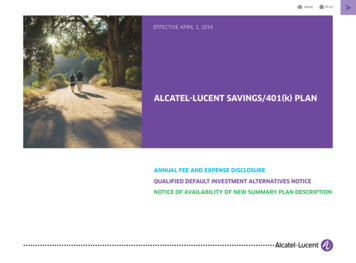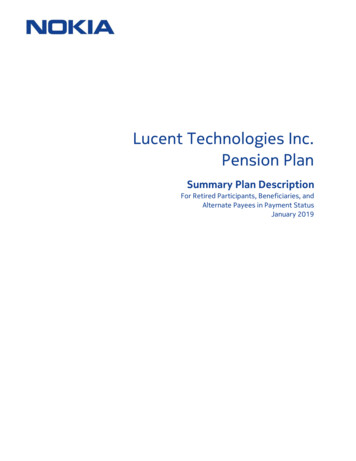
Transcription
Lucent Technologies Inc.Pension PlanSummary Plan DescriptionFor Retired Participants, Beneficiaries, andAlternate Payees in Payment StatusJanuary 2019
[This page intentionally left blank]Nokia LTPP, 1/2019
Table of ContentsPageIntroduction .1Terms You Should Know .2What Happens To My Plan Benefit When I Die? .5If You Die After Commencing Your Plan Benefit (and You Elected an AnnuityForm of Payment) . 5What Happens To My Plan Benefit If I Get Divorced? .6What Happens To My Plan Benefit If I Am Rehired By The Nokia Group?.7If You Elected an Annuity Form of Payment and are Rehired by a Nokia GroupCompany . 7If You Took a Lump-Sum Distribution of Your Plan Benefit and Are Rehired bythe Plan Sponsor or an Affiliate that Participates in the Plan . 7Claims And Appeals .9How to File a Claim . 9How to File an Appeal . 10Your Rights Under ERISA . 12Your Right to Receive Information About the Plan and About Your BenefitsUnder the Plan. 12Your Right to Prudent Actions by the Plan’s Fiduciaries . 12Enforcing Your Rights . 13Assistance with Your Questions . 13Other Information About The Pension Plan . 14The Official Plan Documents Are Controlling . 14The Company Has the Right to Amend, Modify or Terminate the Pension Plan . 14Benefits Are Generally Not Assignable . 15Nokia LTPP, 1/2019Page i
Table of ContentsBenefits Are Guaranteed, Up to Certain Limits, by the Pension BenefitGuaranty Corporation . 16Administrative Information . 17Important Contacts. 19Page iiNokia LTPP, 1/2019
IntroductionNokia’s benefit programs can be an important part of your financial security. Your benefitunder the Lucent Technologies Inc. Pension Plan (the “Pension Plan” or the “Plan”), whencombined with Social Security and other retirement savings, provides you the opportunityto build a balanced retirement portfolio that can help you meet your long-term financialand retirement goals.This booklet--called a summary plan description (“SPD”)--is intended to summarize specificterms of the Plan that apply to Plan Participants, Beneficiaries, and Alternate Payees inpayment status. This SPD presents information regarding the Plan as of January 1, 2019. Itis for informational purposes only. The actual terms of the Plan are reflected in the officialPlan document, a copy of which can be obtained by writing to the Plan Administrator (see“Important Contacts” later in this SPD). Every care has been taken to ensure that thissummary is accurate. In the event of a conflict between this document and the terms of theofficial Pension Plan document, the official Pension Plan document will control.Note: This document relates only to the Lucent Technologies Inc. Pension Plan and only toParticipants, Beneficiaries, and Alternate Payees who are in payment status. In this regard,it only provides information relevant to such status. For a summary of the Plan’s provisionsrelating to other issues (for example, the Plan’s terms regarding service accrual, vesting,breaks in service, or available payment forms), consult the Summary Plan Description thatwas available to you at the time you terminated from employment. Note also that there areseparate SPDs for Participants in the Pension Plan who are still actively employed by Nokiaof America Corporation (the “Company”) and any affiliates that participate in the Plan andalso separate SPDs for other Company-sponsored pension plans.The Company expects to continue the Plan but reserves the right toamend, modify, or terminate it, in whole or in part, at any time byresolution of the Company’s Board of Directors or its duly authorizeddelegate(s). Note: if the Plan were to be terminated, there arespecific rules under federal law that must be followed.Nokia LTPP, 1/2019Page 1
Terms You Should KnowSeveral words and phrases have a specific meaning under the Plan. This section explainsthose terms so that you can better understand your benefits. These terms are capitalizedwhen they appear in this SPD.Alternate Payee: a person who, pursuant to the terms of a Qualified Domestic RelationsOrder, is recognized by the Pension Plan as having a right to receive all, or a portion of, aparticipant’s Plan benefit.Beneficiary/ies: as it pertains to a Joint and Survivor Annuity or a Period Certain and LifeAnnuity, the person or persons who are eligible to receive a reduced monthly benefit uponthe death of the Participant.Code: the Internal Revenue Code of 1986, as amended.Company: Nokia of America Corporation (formerly known as Alcatel-Lucent USA Inc.), aDelaware corporation, and any successor entity.Deferred Vested Pension: a type of pension that does not qualify as a Service Pension.Disability Pension: pertains to Participants who qualify for a disability pension.Employee Benefits Committee: the committee appointed by the Company to undertakecertain administrative responsibilities for the Pension Plan.ERISA: the Employee Retirement Income Security Act of 1974, as amended.IRS: the Internal Revenue Service, part of the U.S. Department of the Treasury.Joint and Survivor Annuity: a form of payment that provides you with monthly paymentsfor your life with survivor protection for your Beneficiary. This is the automatic paymentmethod under the Plan if you are married when your Plan benefit payments begin. Uponyour death, your Beneficiary will receive reduced monthly payments for life. If your Planbenefit is being paid in this form and you have a pop-up feature and your Beneficiary diesbefore you but after your payments begin, your remaining payments will be increased bythe amount of the original reduction.Mandatory Portability Agreement (MPA): an agreement, effective January 1, 1985, amongAT&T and its former affiliates (called “interchange companies”). The agreement providesfor mutual recognition of service-credit and transfer of benefit obligations for certainPage 2Nokia LTPP, 1/2019
Terms You Should Knowindividuals who leave one interchange company and are later employed by anotherinterchange company.Nokia Group: the Company and each entity required to be aggregated with the Companyunder Sections 414(b), (c), (m) or (o) of the Code, i.e., all companies (parents, subsidiaries,and affiliates) that are under “common control” with the Company, plus the Company.Effectively, this means all “Nokia group” companies.Nokia Benefits Resource Center: the official service center for all services related to thePension Plan. The Nokia Benefits Resource Center is available to you from 9:00 a.m. to 5:00p.m., ET, Monday through Friday. Call 1-888-232-4111 and select “Retirement andInvestments”, then select “Pension”. Information about your Pension Plan benefit is alsoaccessible, and pension transactions can be initiated, online through the Your BenefitsResources (YBR) website at http://resources.hewitt.com/nokia, 24 hours a day, sevendays a week.Normal Retirement Age (NRA): your 65th birthday. Note: This is the Plan’s definition ofnormal retirement age, which might differ from your retirement age for purposes of othertypes of benefits, such as Social Security.Participant: an individual who is entitled to receive a Plan benefit.Pension Plan: the Plan, an employee pension benefit plan established and maintained bythe Company. (Prior to October 1, 1996, the Plan was named the AT&T Pension Plan.)Pension Plan Administrator: see Plan Administrator.Pensioner Death Benefit: a benefit payable to an eligible beneficiary (which, for thepurposes of the Pensioner Death Benefit, is limited to the Participant’s surviving Spouse,surviving dependent children, and other surviving dependent relatives) upon the death of aretired Participant in payment status whose benefit was payable as a Service Pension or aDisability Pension.Period Certain and Life Annuity: an annuity paid for the life of the Participant or for aspecific period of years, whichever is longer, with the provision that, after the Participant’sdeath, the Participant’s Beneficiary(ies) shall receive the balance of payment (if any) dueduring the stated minimum period of years.Plan: see Pension Plan.Plan Administrator: the Company.QDRO: see Qualified Domestic Relations Order.Qualified Domestic Relations Order (QDRO): a court order in a divorce, legal separation, orsimilar proceeding, that requires part or all your pension to be paid to meet a propertyNokia LTPP, 1/2019Page 3
Terms You Should Knowsettlement agreement, alimony, child- or dependent-support payments and that the PlanAdministrator determines meets the requirements of a “qualified domestic relations order”within the meaning of the Code, ERISA, and the terms of the Plan. See QDRO Administrationunder “Important Contacts” for details on whom to contact in the event your pensionbenefit is subject to such an order or to obtain (without charge) a copy of the PensionPlan’s procedures governing QDROs.Service Pension: a type of pension that provides benefits based on the attainment of acertain number of years in age and in service, among other things.Single Life Annuity: a form of payment that provides monthly payments to you for life withno payments continuing after your death.SMM: see Summary of Material Modification (SMM).SPD: see Summary Plan Description (SPD).Spouse: the person to whom you are lawfully married. Your Spouse can be a person of thesame sex if you and such other person were lawfully married in a jurisdiction thatrecognizes same-sex marriage (even if you and your spouse reside in a state or otherjurisdiction that does not recognize same-sex marriages). Note: The term Spouse does notinclude individuals (whether of the same or opposite sex) who have entered into aregistered domestic partnership, a civil union, or other similar formal relationshiprecognized under state or other law that is not denominated as a “marriage.”Summary of Material Modification (SMM): a written summary of material changes to theterms of an employee benefit plan. SMMs typically modify information presented in thePlan’s most recently issued Summary Plan Description (SPD).Summary Plan Description (SPD): a written summary of the material terms of an employeebenefit plan. SPDs summarize the rights, benefits, and responsibilities of participants andbeneficiaries in a plan and include information regarding the terms of the plan, such aseligibility requirements and what benefits the plan provides and, also regarding how thosebenefits may be obtained. An SPD may be modified from time to time by a Summary ofMaterial Modification (SMM).Page 4Nokia LTPP, 1/2019
What Happens To My Plan Benefit When I Die?If You Die After Commencing Your Plan Benefit (and You Elected an Annuity Form ofPayment)If you terminated employment and elected an annuity form of payment, whether benefitscontinue after your death will depend on the form of annuity that you elected. Single Life Annuity. If you elected to receive your Plan benefit in the form of a SingleLife Annuity, your benefit will end as of your death and no further payments will bemade. Joint and Survivor Annuity. If you elected to receive your Plan benefit in the form ofa Joint and Survivor Annuity, upon your death, your Beneficiary will receive areduced monthly benefit for the remainder of his or her life. Period Certain and Life Annuity. If you elected to receive your Plan benefit in theform of a Period Certain and Life Annuity, upon your death your Beneficiary(ies) shallreceive the balance of payments (if any) due during the stated minimum period ofyears.Nokia LTPP, 1/2019Page 5
What Happens To My Plan Benefit If I Get Divorced?By law and the terms of the Plan, your Plan benefits are generally “inalienable,” meaningthey cannot be assigned for the benefit of creditors. (See “Benefits Are Generally NotAssignable” later in this SPD.) Your Plan benefits also cannot be divided or assigned toanother person in connection with any marital settlement or divorce except pursuant to aQualified Domestic Relations Order. In order for a domestic relations order (i.e., an order ofa court in connection with a divorce or other domestic relations proceeding) to berecognized by the Plan, the order must meet the requirements of being Qualified DomesticRelations Order. In this regard, you may obtain, without charge, a copy of the Plan’s QDROProcedures from the QDRO Administrator (see “Important Contacts” later in this SPD).Note: If, when you terminated employment and commenced payment of your pensionbenefit, your then Spouse was designated as your Beneficiary, that person will continue tobe your Beneficiary regardless of any subsequent divorce or entry of a QDRO. Forexample, if you were married to Spouse A at the time you commenced receiving your Planbenefit, elected a Joint and Survivor Annuity with Spouse A as your Beneficiary (survivorannuitant), then divorced Spouse A and later married Spouse B, when you die, Spouse A—not Spouse B—will still be considered the Beneficiary with respect to your Plan benefit,entitled to receive a reduced monthly benefit from the Plan for his/her life. In this regard,any QDRO that might be or might have been entered in favor of Spouse B (or evenSpouse A) after you commenced receiving your Plan benefit will only affect the portion ofthe Plan benefit that is payable to you; it will not in any way affect the survivor annuity thatis payable, upon your death, to (former) Spouse A.Page 6Nokia LTPP, 1/2019
What Happens To My Plan Benefit If I Am Rehired By The NokiaGroup?If You Elected an Annuity Form of Payment and Are Rehired by a Nokia Group Company If you terminated employment from the Nokia Group, elected to receive your Planbenefit in an annuity form of payment, and are rehired by any Nokia GroupCompany, your Plan benefit payments will be suspended for as long as you continueto work for a Nokia Group company. Your Plan benefit will again becomedistributable upon your subsequent termination of employment from the NokiaGroup or your death. You will be able to elect to recommence your Plan benefit inany form of payment then available under the Plan (subject to any prior survivingSpouse rights, if applicable, and subject further to the written notarized consent ofthe person who is your Spouse as of the date of recommencement).Note: The above-described suspension rules apply to your period of re-employment priorto reaching your Normal Retirement Age (NRA). After reaching your NRA, whether your Planbenefit payments are suspended depends on the number of hours per month for which youare paid. Note further: Special suspension-of-benefit rules apply if you are covered by theMandatory Portability Agreement (MPA). Contact the Nokia Benefits Resource Center if youare MPA-eligible.If You Took a Lump-Sum Distribution of Your Plan Benefit and Are Rehired by the PlanSponsor or an Affiliate that Participates in the PlanIf you terminated employment from the Nokia Group, took a Lump Sum Distribution of yourPlan benefit, and are rehired by the Company or an affiliate of the Company thatparticipates in the Plan, you may be permitted to repay your Lump Sum to the PensionPlan, inclusive of interest if either of the following applies to you: You are covered by the Mandatory Portability Agreement (MPA), in which case youwill be permitted to repay your Lump Sum Distribution, with interest, solely for thepurpose of having your Plan-recognized service and related pension assets latertransfer to another “former affiliate” within the meaning of the MPA. (Contact theNokia Benefits Resource Center if this applies to you.) You have a Deferred Vested Pension benefit, in which case, you will be permitted torepay your Lump Sum Distribution, with interest, solely with the purpose of allowingyou to be credited with Plan-recognized service to grow into a Service Pension.Nokia LTPP, 1/2019Page 7
What Happens To My Plan Benefit If I Am Rehired By The Nokia Group?Note: If the Lump Sum benefit distribution was 5,000 or less, your right to repaywith interest expires the later of (a) the end of the fifth Plan Year after the year inwhich the Lump Sum Distribution was made; or (b) the date 6 months after theParticipant’s first reemployment date. In the event of a Participant who received aLump Sum Distribution in excess of 5,000, the Participant’s right to makerepayment shall expire on the date 6 months after the Participant’s firstreemployment date.Page 8Nokia LTPP, 1/2019
Claims and AppealsThe Pension Plan maintains claims and appeals procedures designed to afford you a fairand timely review of any claim you might have relating to the Pension Plan. Generally, youare legally required to pursue all your claim and appeal rights on a timely basis beforeseeking any other legal recourse, including litigation.How to File a ClaimParticipants and beneficiaries (if applicable), and any individual duly authorized by them,have the right to file a claim for benefits due under the terms of the Plan, to enforce theirrights under the terms of the Plan, or to clarify their rights to future benefits under theterms of the Plan.All claims must be in writing. Include with your claim pertinent and supporting documents.Send your claim to the Plan Administrator (see “Important Contacts”).All claims must be brought within one year of the dateon which the claim arises.You will receive a written notice of the Plan Administrator’s decision within 90 days afterthe Plan Administrator receives your claim. If the Plan Administrator needs more than 90days to make a decision, the Plan Administrator will notify you in writing within the initial90-day period and explain why more time is required. An additional 90 days (for a total of180 days) may be taken if the Plan Administrator sends this notice. The extension noticewill show the date by which the Plan Administrator’s decision will be sent.If your claim is denied, in whole or in part, the notice advising you of the PlanAdministrator’s decision will include the specific reason(s) for the decision, reference to thePlan provisions on which the decision is based, a description of any additional informationnecessary to perfect the claim, and a description of the Plan’s review procedures (alongwith a statement of your rights under Section 502(a) of ERISA to bring a civil action after adenial of an appeal).Nokia LTPP, 1/2019Page 9
Claims and AppealsHow to File an AppealIf your claim is denied, in whole or in part, an appeal process is available to you. You or yourauthorized representative may appeal the denial within 60 days after the denial is received.Appeals must be in writing. Send your written appeal to the Employee Benefits Committee(see “Important Contacts” later in this SPD).All appeals must be submitted within sixty (60) days of receivingnotice of the Plan Administrator’s decision.If you or your representative submits a written request for review of a denied claim, you oryour representative have the right to: Review pertinent Plan documents relevant to your claim, which you can obtain freeof charge, and Send to the Employee Benefits Committee a written statement of the issues andany other documents in support of the claim for benefits or other matter underreview.The Employee Benefits Committee will conduct a review and make a final decision within 60days after receipt of a written request for review. If special circumstances cause theEmployee Benefits Committee to need additional time to make a decision, a representativeof the Committee will notify you in writing within the initial 60-day review period andexplain why such additional time is needed. An additional 60 days—for a total of 120 days—may be taken if the Employee Benefits Committee sends this notice.You will receive a written notice of the Employee Benefit Committee’s decision. If your claimis denied, in whole or in part, the notice advising you of the Employee Benefit Committee’sdecision will include the specific reasons for the decision, reference to specific Planprovisions on which the decision was based, a statement that you are entitled to receiveupon request and free of charge copies of all documents and information relevant to yourclaim, and a statement of your rights to bring a civil action under Section 502(a) of ERISA.If the Employee Benefits Committee does not respond to your claim within 60 days (or 120days if the notice described above has been given), you will be considered to haveexhausted your administrative remedies under the Pension Plan and will be entitled topursue a remedy under Section 502(a) of ERISA.The Employee Benefits Committee serves as the final review committee under the PensionPlan. Decisions by the Employee Benefits Committee are conclusive and binding on allparties and not subject to further internal review. The Committee has sole and completediscretionary authority to determine conclusively for all parties, and in accordance with theterms of the documents or instruments governing the Pension Plan, any and all questionsPage 10Nokia LTPP, 1/2019
Claims and Appealsarising from administration of the Pension Plan and interpretation of all Pension Planprovisions, determination of all questions relating to participation and eligibility forbenefits, determination of all facts, the amount and type of benefits payable to anyParticipant, and construction of all terms of the Pension Plan.Nokia LTPP, 1/2019Page 11
Your Rights Under ERISAAs a Participant in the Pension Plan, you are entitled to certain rights and protections underERISA, as described below.Your Right to Receive Information About the Plan and About Your Benefits Under thePlanUnder ERISA, all Plan Participants have the right: To examine, without charge, at the Pension Plan Administrator’s office and at otherspecified locations such as worksites, all documents governing the Pension Plan anda copy of the latest Annual Return/Report (the Form 5500) filed by the PlanAdministrator with the U.S. Department of Labor. The Plan’s Annual Return/Report(Form 5500) is also available at the Public Disclosure Room, Employee BenefitsSecurity Administration, U.S. Department of Labor, 200 Constitution Avenue N.W.,Washington, D.C. To obtain, upon written request to the Plan Administrator, copies of all documentsgoverning the operation of the Plan and copies of the latest Annual Return/Report(Form 5500) and updated Summary Plan Description. The Pension PlanAdministrator may make a reasonable charge for such copies. To obtain a statement telling you whether you have a right to receive a pension atNormal Retirement Age (age 65) and if so, what your benefits under the Plan wouldbe at Normal Retirement Age if you were to stop working now. This statement mustbe requested in writing and is not required to be given more than once every twelve(12) months. The Pension Plan must provide this statement free of charge.Your Right to Prudent Actions by the Plan’s FiduciariesIn addition to creating rights for Plan Participants, ERISA imposes duties upon the peoplewho are responsible for the operation of the Pension Plan. The people who operate thePension Plan, called “fiduciaries” of the Pension Plan, have a duty to do so prudently and inthe interest of you and other Participants and Beneficiaries. No one, including the Companyor any other person, may fire you or otherwise discriminate against you in any way toprevent you from obtaining a pension benefit or exercising your rights under ERISA.Page 12Nokia LTPP, 1/2019
Your Rights Under ERISAEnforcing Your RightsIf your claim for a benefit under the Pension Plan is denied or ignored, in whole or in part,you have a right to know the reasons for the denial, to obtain copies of documents relatingto the decision without charge, and to appeal any denial, all within certain time limits.Under ERISA, there are steps you can take to enforce the above rights. For example, if yourequest a copy of Plan documents or the latest Annual Return/Report (Form 5500) fromthe Plan Administrator and do not receive them within 30 days, you may file suit in aFederal court. In such a case, the court may require the Plan Administrator to provide thematerials to you and also to pay you up to 110 a day until you receive the materials(unless the materials were not sent because of reasons beyond the control of the PlanAdministrator). If you have a claim for benefits that is denied or ignored, in whole or in part,you may file suit in a state or Federal court. In addition, if you disagree with the Plan’sdecision or lack thereof concerning the qualified status of a domestic relations order, youmay file suit in Federal court. If it should happen that the Pension Plan’s fiduciaries misusethe plan’s money, or if you are discriminated against for asserting your rights, you may seekassistance from the U.S. Department of Labor, or you may file suit in a Federal court.The court will decide who should pay court costs and legal fees. If you are successful, thecourt may order the person you have sued to pay these costs and fees. If you lose, thecourt may order you to pay these costs and fees, for example, if it finds your claim isfrivolous.Assistance with Your QuestionsIf you have any questions about the Pension Plan, you should contact the PlanAdministrator. If you have any questions about this statement of your ERISA rights or aboutyour rights under ERISA, or if you need assistance in obtaining documents from the PlanAdministrator, you should contact the nearest office of the Employee Benefits SecurityAdministration, U.S. Department of Labor, listed in your telephone directory, or the Divisionof Technical Assistance and Inquiries, Employee Benefits Security Administration, U.S.Department of Labor, 200 Constitution Avenue N.W., Washington, D.C. 20210. You may alsoobtain certain publications about your rights and responsibilities under ERISA by going towww.dol.gov/EBSA or calling the publications hotline of the Employee Benefits SecurityAdministration at (866) 444-EBSA (3272).Nokia LTPP, 1/2019Page 13
Other Information About the Pension PlanThe Official Plan Documents Are ControllingThis booklet, called an SPD, is intended to summarize the material terms of the Plan. TheSPD is for informational purposes only. The actual terms of the Plan are reflected in theofficial Pension Plan document, a copy of which can be obtained by writing to the PensionPlan Administrator (see “Important Contacts” on the back cover of this SPD). Every care hasbeen taken to ensure that this summary is accurate. In the event of a conflict between thisSPD and the terms of the official Pension Plan document, the official Pension Plandocument will control.Because of the many detailed provisions of the Plan, no one other than the personnel orentities identified is this summary (see “Important Contacts” on the inside back cover ofthis SPD) is authorized to advise you concerning your benefits, regarding the terms of thePlan. Questions regarding your benefits, the Pension Plan should be addressed as indicatedin this SPD. Neither the Company nor the Pension Plan is bound by statements made byunauthorized persons or entities. Moreover, in the event of a conflict between anyinformation provided to you by an authorized resource and this SPD, this SPD (or theofficial Pension Plan document in the event of a conflict between this SPD and the officialPension Plan document) will control.The Company Has the Right to Amend, Modify, or Terminate the Pension PlanThe Company expects to continue the Pension Plan. However, the Company has expresslyreserved the right to amend, modify, or terminate the Pension Plan at any time and for anyreason.In the rare event that the Pension Plan were terminated, you could still have rights to futurebenefit payments. You might also have certain rights to benefits insured by the PensionBenefit Guaranty Corporation. See below under “Benefits Are Guaranteed, Up to CertainLimits, by the Pension Benefit Guaranty Corporation.” If the Pension Plan were terminated,the rights of all affected Participants and beneficiaries, if applicable, to pension benefitscomputed as of the date of terminat
Note: This is the Plan's definition of normal retirement age, which might differ from your retirement age for purposes of other types of benefits, such as Social Security. Participant: an individual who is entitled to receive a Plan benefit. Pension Plan: the Plan, an employee pension benefit plan established and maintained by the Company.
